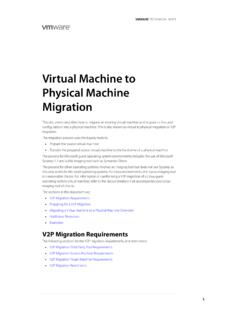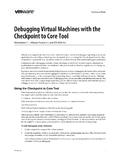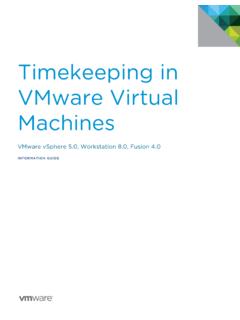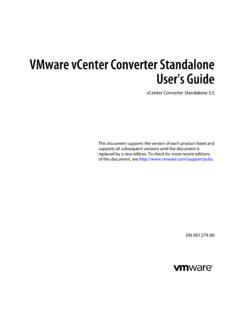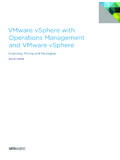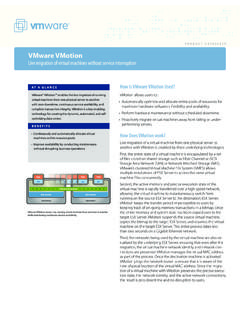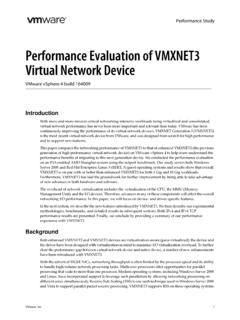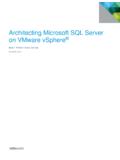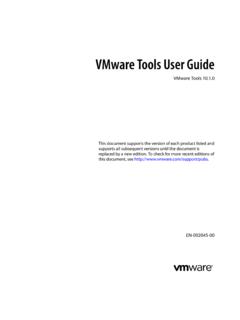Transcription of Understanding VMware vSphere DRS Performance
1 Understanding vSphere DRS Performance VMware vSphere 6 Performance STUDY OCTOBER 2016 Understanding vSphere DRS Performance Performance STUDY | 2 Table of Contents Introduction .. 4 How DRS Works .. 4 Effective VM Placement .. 4 Efficient Load Balancing .. 5 Calculating VM Resource Demand .. 5 Detecting VM Demand Changes .. 5 Cost Benefit Analysis .. 5 Factors That Affect DRS Behavior .. 6 DRS Automation Levels .. 6 DRS Aggression Levels ( Migration Threshold) .. 6 VM Overrides .. 7 VM/Host 8 Reservation, Limit, and Shares .. 11 Reservation .. 11 Limit .. 11 Shares .. 11 Advanced Options .. 12 Troubleshooting and Monitoring .. 13 Recommendations .. 14 History .. 15 DRS Faults .. 15 CPU Utilization Summary .. 16 Memory Utilization Summary .. 16 Case Studies .. 16 Case Study 1 DRS Provides Effective VM Initial Placement .. 16 Expectation .. 17 Observation.
2 18 Case Study 2 Memory Considerations for DRS Load Balancing (VM Consumed vs. Active Memory) ..18 Expectation .. 20 Observation .. 21 Case Study 3 Cluster Balance Impacted by VM Overrides .. 22 Expectation .. 24 Observation .. 24 Understanding vSphere DRS Performance Performance STUDY | 3 Case Study 4 Guaranteeing Resources for VMs .. 24 Expectation .. 25 Observation .. 26 Case Study 5 Resource Prioritization Using Shares .. 26 Expectation .. 27 Observation .. 30 Case Study 6 How DRS Migration Threshold Impacts Cluster Balance .. 30 Observation .. 32 Case Study 7 DRS Considers Prerequisite Moves for Placement .. 32 Expectation ..33 Observation ..33 Conclusion .. 34 References .. 34 Understanding vSphere DRS Performance Performance STUDY | 4 Introduction VMware vSphere Distributed Resource Scheduler (DRS) is the resource scheduling and load balancing solution for vSphere .
3 DRS works on a cluster of ESXi hosts and provides resource management capabilities like load balancing and virtual machine (VM) placement. DRS also enforces user-defined resource allocation policies at the cluster level, while working with system-level constraints. Although DRS is widely deployed and generally understood, questions about "how" DRS does what it does are not uncommon. Not knowing exactly how DRS works often leads to confusion and improper expectations about DRS behavior and its Performance . In this paper, we demystify DRS. First, we give an overview of how DRS works. Next, we explain some of the factors that influence DRS behavior and how they can be monitored. Finally, we cover some common Performance scenarios that customers raised as issues and show what we can learn about DRS from these scenarios. How DRS Works The main goal of DRS is to ensure that VMs and their applications are always getting the compute resources that they need to run efficiently.
4 In other words, DRS strives to keep your VMs happy1. It does this by ensuring that newly powered-on VMs get all the required resources soon after they are powered on, and the resource utilization is always balanced across the cluster. From time to time, VMs workloads may change, and with many VMs with changing workloads, there can be imbalance in the cluster. Each of these can degrade application Performance . DRS solves these problems by regularly monitoring the cluster balance state once every five minutes, by default, and then takes the necessary actions to fix any imbalance. DRS automatically determines which virtual machines would benefit from a move to another host and live migrates the VM onto the new host using vMotion. In this way, DRS ensures each virtual machine in the cluster gets the host resources like memory and CPU that it needs. Let s take a closer look at how DRS achieves its goal of ensuring VMs are happy, with effective placement and efficient load balancing.
5 Effective VM Placement When a VM is being powered up in a DRS cluster, DRS runs its algorithm to determine the right ESXi host for it to be powered up on. This decision, also known as VM placement (or initial placement) is made based on the expected change in resource distribution (after ensuring that there are no constraint violations if the VM was placed on the host). One of the first steps in ensuring good VM Performance is to make sure that the VM gets all the resources it needs as soon as it is powered on. DRS considers the demand of a VM, so it will never be short of resources whenever it is started. A VM s demand includes the amount of resources it needs to run, and the way DRS calculates this is described in Calculating VM Resource Demand. 1 For VMs and their applications to perform well, they rely on DRS to provide the necessary resources.
6 In reality, application Performance depends on more than just the availability of resources. DRS can only ensure that lack of resource availability is not the reason for any application Performance issues in your cluster. Understanding vSphere DRS Performance Performance STUDY | 5 VM placement is a key aspect of DRS Performance and must be effective because this reduces the amount of load balancing that is required. When DRS chooses the optimal host with the closest match of resources, and it does not disturb the balance of resources across the cluster, this is effective VM placement. Even with optimal placement, VM workloads may change over time, and there could be some imbalance in the cluster from time to time. This is when load balancing is required. Efficient Load Balancing When the host resources in a cluster are more or less evenly utilized, then the cluster is well balanced.
7 DRS uses a cluster-level balance metric to make load-balancing decisions. This balance metric is calculated from the standard deviation of resource utilization data from hosts in the cluster. DRS runs its algorithm once every 5 minutes (by default) to study imbalance in the cluster. In each round, if it needs to balance the load, DRS uses vMotion to migrate running VMs from one ESXi host to another. Calculating VM Resource Demand In calculating the resource utilization, DRS looks for the demand for every running VM in the cluster. VM demand is the amount of resources that the VM currently needs to run. For CPU, demand is calculated based on the amount of CPU the VM is currently consuming. For memory, demand is calculated based on the following formula. VM memory demand = Function(Active memory used, Swapped, Shared) + 25% (idle consumed memory) In other words, by default, DRS balances memory workloads based mostly on a VM s active memory usage, while considering a small amount of its idle consumed memory as a cushion for any increase in workload.
8 This behavior enables you to efficiently run memory workloads in your DRS clusters, even with over-commitment. Detecting VM Demand Changes During each round, along with resource usage data, DRS also collects resource availability data from each and every VM and host in the cluster. Data like VM CPU average and VM CPU max over the last collection interval depict the resource usage trend for a given VM, while availability data like VM CPU Ready Time2 and VM Memory Swapped3 indicate resource shortage, if any, for the VM (availability data indicate if a VM is running short of resources). DRS then correlates the resource usage data with the availability data and runs its load-balancing algorithm before taking necessary vMotion actions in order to keep the cluster balanced and to ensure that VMs are always getting the resources they need to run. Cost Benefit Analysis vMotion of live VMs comes with a Performance cost, which depends on the size of the VM being migrated.
9 If the VM is large, it will use a lot of the current host s and target host s CPU and memory for vMotion. The benefit, however, is in terms of Performance for VMs on the source host, the migrated VM on the destination host, and improved load balance across the cluster. 2 CPU ready time is the amount of time a VM was in a state where it was ready to execute, but there were not any CPU resources available. CPU ready time is usually a very good indicator of CPU contention in a host. 3 VM memory swapped is the amount of idle consumed memory that has been swapped out of a VM by the host. Understanding vSphere DRS Performance Performance STUDY | 6 Moving a VM to a host with better availability of resources and freeing resources on the source host means having more room for workload changes. The DRS algorithm constantly evaluates the cost and benefit of each load balancing vMotion move.
10 Another factor that comes into play in load balancing is the VM workload behavior. If a VM s application tends to follow a spiky trend, DRS tries to detect such spikes by looking at VM resource usage trends, as mentioned in the section Detecting VM Demand Changes. Without this behavior, DRS could end up migrating VMs more often than is preferred. Factors That Affect DRS Behavior While DRS constantly works to ensure that VMs are getting the resources they need, it also provides several useful customizations that work very well for a variety of cluster needs. By Understanding these customizations, you can get the best Performance out of DRS and have it meet your expectations. In this section, we discuss some of the customizations and factors that affect DRS and how to use them for best Performance . DRS Automation Levels During initial placement and load balancing, DRS generates placement and vMotion recommendations, respectively.
